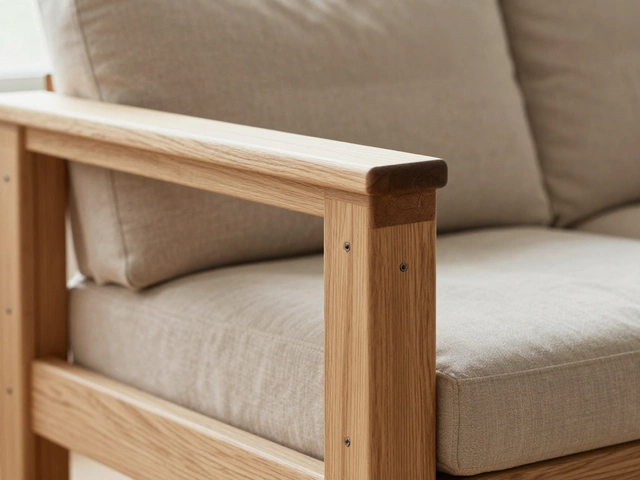Storage Cost Breakdown: What Does Storage Cost Include?

Storage costs can sneak up on you if you’re not paying close attention. Everyone talks about the “monthly rent,” but that’s only part of the story. Rental charges might look low at first, but the real number on your bill often includes a bunch of extras—some helpful, some just there to pad the company’s pockets.
Ever wondered why your total at checkout is higher than you expected? Besides the unit itself, you could be paying for gate access fees, climate control, insurance, and even a one-time admin charge just to sign up. Some places toss in charges for things you might never use, like pest control or 24-hour access.
The more you know about what’s included, the easier it is to compare options—and avoid unnecessary fees. Thinking about storing grandma’s couch or your kid’s toys? This guide will show you what you’re really paying for, what you can skip, and some tricks to keep those costs lower each month.
- What You Really Pay For
- Types of Storage Units and Costs
- Extra Fees Nobody Talks About
- Why Insurance Matters (and Costs Extra)
- Location, Size, and Features—What Changes the Price?
- Tips to Keep Your Storage Bill Low
What You Really Pay For
Break down your storage bills and you’ll notice the monthly rent is just the start. According to the Self Storage Association, "nearly half of renters report surprise at the total cost of their first storage bill." Nobody likes that kind of shock, so here's what's actually bundled into what you pay.
First up, your base rental price. This is the flat monthly fee for your unit—the number that usually gets advertised the biggest. It’s based mostly on the unit’s size but also its type (like outdoor, indoor, or climate-controlled) and which floor it’s on. Pick a ground-level, drive-up unit? You’ll probably pay more than for one you have to access by elevator.
Then, there’s the security and access features. Keypads, video cameras, security guards, and gate hours can all affect what facilities charge. Some companies openly roll these into your monthly rent, but others list them separately as “access fees” or “security surcharges.” Pay attention to which one you’re dealing with, because access 7 days a week is awesome only if you actually need it.
Space isn’t always clean, pest-free, or ready for your stuff by default. Some places charge one-off fees for move-in (often called "admin fees"), pest prevention, or even cleaning. If they mention a “setup fee,” ask exactly what it covers and if it’s negotiable.
Lastly, a lot of companies require insurance—or automatically add it to your bill, even if you already have homeowners or renters coverage. Sometimes, you can opt out, but you'll have to provide your own proof.
- Storage cost usually covers rent, security, and access features.
- Watch for extra admin, pest, or cleaning fees.
- Check if insurance is optional or automatically included.
Tip: Before signing, always ask for a written list of recurring and one-time charges. It’s the only way to know what you’re really committing to and to avoid being caught off guard when your bill rolls in next month.
Types of Storage Units and Costs
The type of storage unit you choose makes a huge difference in what you pay each month. Here’s how it usually works: the more features or space you need, the more you’ll fork over. Standard self-storage units come in sizes as small as a closet or as big as a one-car garage. A basic 5x5 unit runs about $40 to $60 per month, while a massive 10x30 unit can easily cost over $200 in city areas.
Then you’ve got climate-controlled units. These are airtight and keep your stuff at steady temps, perfect for wood furniture, electronics, or anything that hates humidity. Expect to pay 20-50% more for these. According to SpareFoot, the storage marketplace,
“Climate-controlled storage spaces typically rent for about $75 per month for a 5x5 unit and $225 for a 10x20 unit.”
Drive-up units are popular for easy loading and unloading, especially if you’re stashing heavy items. There’s usually a small extra charge for that roll-up access—think $10-$20 more compared to similar-sized inside units.
- Storage cost also changes based on indoor versus outdoor access; indoor is safer, outdoor is handier.
- Premium units (with keypads, alarms, or even staff on call) sometimes add another $25-$40 per month.
The cheapest option? Portable containers, like PODS, which live in your driveway and can be hauled to a facility. They start around $100 monthly, but that low rate can jump once you add delivery and pickup fees.
So before locking in your choice, look closely at what you actually need. You’ll save cash by skipping fancy extras, picking the smallest space that fits your stuff, and not paying for climate-control unless your things genuinely require it.
Extra Fees Nobody Talks About
This is where most people get a shock: the hidden costs that sneak onto your bill after you sign the storage contract. It’s never just the “rent.” Companies stay quiet about a bunch of little add-ons that can really pad your monthly payment.
Some of the most common extra charges include:
- Administrative Fees: Most places charge a one-time setup or admin fee, usually between $15 and $30, just for opening your account—nothing to do with the actual storage cost.
- Lock Fees: Some facilities require that you buy a lock from them. You could get one for half the price at a hardware store, but they sometimes insist you buy theirs for $15–$25.
- Gate Access or Security Fees: A few companies add a monthly “security” or “gate access” fee, which can be $5–$15 a month, even if you never visit your unit after move-in.
- Pest Control Fees: This isn’t always mentioned upfront. Some places add $2–$5 per month to cover spraying for bugs and rodents.
- Climate Control Surcharge: For units with temperature or humidity control, you’ll often see a bump in cost—sometimes more than 20% over a non-climate-controlled unit.
- Late Payment Fees: If you miss your due date, expect an automatic late fee, which can jump to $20–$50 depending on the facility and how late you are.
It’s smart to ask for a detailed fee list before signing anything. Some spots bundle features like pest control or basic insurance into the main price, but others tack on every little convenience as a separate line item.
If you want to save, show up with your own lock, pay on time, and always read the fine print. It’s not just about finding the cheapest monthly rent—it’s knowing what’s going to get tagged onto your bill month after month.

Why Insurance Matters (and Costs Extra)
If you think your rental fee covers everything, think again. Most storage facilities require insurance for the stuff you stash away. Even if it’s just boxes of holiday decorations, facilities don’t want to be responsible if something happens. That’s where the real kicker comes in—insuring your storage unit usually means more out-of-pocket costs each month.
Few people realize that their homeowners or renters policy often doesn't fully cover belongings in a separate storage facility. According to the Insurance Information Institute, these policies might only cover your items up to 10% of your personal property limit, leaving a pretty big gap if you’ve got your entire living room or valuable equipment in storage.
“If you’re storing items worth more than a few thousand dollars, consider a stand-alone storage insurance policy to avoid expensive mistakes,” says Loretta Worters, spokesperson for the Insurance Information Institute.
Why is this such a sticking point for storage providers? Natural disasters, theft, water leaks, or even rodent problems can all wreck your belongings. And while damage is rare, it does happen—about 20% of storage unit insurance claims relate to water or moisture damage, and theft accounts for another 15%.
| Incident Type | Percent of Claims |
|---|---|
| Water/Moisture Damage | 20% |
| Theft | 15% |
| Fire | 5% |
| Other (Vandalism, rodents, etc.) | 10% |
Most facilities will try to sell you their own policy for around $10–$20 a month, sometimes more for higher coverage. Don’t just pay up—check your current insurance first, and get a quote from a third party. Also, always read the fine print: many facility policies have limits on high-value items like jewelry or collectibles, so you can’t just toss in anything and call it a day.
- Ask if you can use your own storage insurance.
- List your stored objects with photos—proof is your best friend if you ever need to make a claim.
- Don’t underinsure—calculate the real value of your stuff, not just a guess.
Paying extra for insurance might feel like another annoying line item, but if your stuff means anything to you, it’s worth it. Nobody ever thinks they’ll need it, until that one time when you’re really glad you had it. When you’re comparing storage cost at different facilities, make sure to add insurance to the real price, not just the number in the ad.
Location, Size, and Features—What Changes the Price?
Your storage cost is not just about the box you rent—where that box sits and what comes with it make a massive difference. Starting with location: storage units in big cities (think New York, San Francisco, or London) usually cost way more than similar units in smaller towns. Why? Higher land prices, bigger demand, and less available space all mean you pay extra.
Size is pretty straightforward. A basic 5x5-foot unit might feel affordable, but prices jump as you go bigger. For example, according to SpareFoot, a 10x10-foot unit typically costs twice as much as a 5x5, and jumping to a 10x20 can more than triple the cost. Always measure your stuff before picking a size, so you’re not shelling out for empty space.
Features also matter. Climate control is the big one—great for protecting furniture or electronics from humidity, but it adds 20-50% to your bill. Ground-floor drive-up access also usually costs more because it’s just easier to move your stuff. Some facilities even charge more for 24-hour access or top-notch security (like cameras and coded gates). Here’s a quick breakdown of things that affect price:
- Location (city vs suburb vs rural)
- Unit size (measured in square feet/meters)
- Climate control (with or without)
- Access type—ground floor, elevator, drive-up
- Security features (gated, cameras, on-site staff)
- Access hours (24/7 or limited)
A manager at Public Storage shared,
“In urban spots, demand is so high that two units of the same size can be double the price just a few miles apart. Most people underestimate their storage needs, then end up paying for space or features they don’t use.”
So, if you want to keep your storage cost in check, take a good look at these details. Balance what you really need with what the facility is charging for, and don’t pay a premium for features you’ll never use.
Tips to Keep Your Storage Bill Low
Anyone using storage for more than a few months knows how quickly the cost can add up. Good news: most people overpay because they miss a few easy tricks. Here’s how to keep your storage cost way lower without sacrificing space or security.
- Don’t pay for space you don’t need. Take a good look at what you’re storing and get rid of anything you won’t actually use again. Pack boxes tight and stack higher instead of spreading out. Some storage providers even have online calculators to estimate the smallest unit you’ll need.
- Skip unnecessary features. Unless you’re storing something sensitive like electronics or antiques, you probably don’t need climate control or 24-hour access. These premium extras drive up the monthly rate, so stick to basics if you can.
- Shop around—literally. Prices can change a ton from one facility to another, even just within a few miles. Smaller, lesser-known storage businesses sometimes run better promotions than the big name chains, especially if you ask about discounts for first-time customers or longer rental terms.
- Read the fine print before you sign up. Make sure you know about hidden charges, like admin or lock fees, and ask for a breakdown. Some places happily waive little one-time fees if you just mention them up front.
- Bring your own lock. Facilities love to sell you overpriced “security” locks at the counter. A sturdy lock from the hardware store is usually just as good and way cheaper.
- Reconsider insurance fees. Your existing renters or homeowners policy might already cover stored stuff. Check before saying yes to the storage company’s insurance, unless you’re storing high-value items.
The less space and fewer extras you use, the lower your monthly bill. Be nosy, ask questions, and hunt for deals—your wallet will thank you in the long run.





